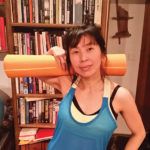Within the next couple of years it is estimated that about half of the population in Europe will suffer from some sort of allergy. Autoimmune diseases are on the rise, especially in our part of the world and nobody can really explain exactly why. While we know that some diseases are genetically predisposed, most have no obvious origins. Scientists have discovered over 100 different autoimmune diseases; more common ones including Crohn’s, lupus, psoriasis, type 1-diabetes and arthritis. Many can become manageable with lifestyle changes in areas such as food and exercise.

While food in most cases is the number one marker in making a difference to health, exercise comes a close second, and depending on the disease, can even come first in helping to regulate the body’s natural immune system.
Whenever you are physically active – going for a walk, a run, riding your bike, going for a swim or attending a dance class – your muscles release substances which affect the immune system, so you get an anti-inflammatory effect. Studies have proven that patients who suffer from rheumatoid arthritis feel less pain when they exercise regularly than patients who don’t exercise. So exercise not only makes our heart, lungs and muscles stronger, it also helps in boosting the immune system.
In autoimmune diseases suspected to be caused by the person being overweight, in particular too much visceral fat (the fat around the organs), like scleroses, rheumatoid arthritis and type 1-diabetes, weight loss can aid in prevention or worsening of these conditions.
Finally exercise can also work for some people as a stress reliever. A Swedish study has shown stress to be a significant marker for autoimmune diseases such as psoriasis, lupus, type-1 diabetes, scleroses and inflammation in the intestines.
For these reasons alone exercise is worth prioritising in your life, especially if you are susceptible to inflammation and/or autoimmune disease.
So what kind of exercise does science recommend? The short answer is any and all.
Whether you are going for a 20 minute brisk walk every day, lacing up your running shoes, dancing or lifting heavy things, your body will respond by producing endorphins to lift your mood, your heart and lungs will be strengthened and your muscles will produce anti-inflammatory substances.
If you are suffering from arthritis in your knees or hips, running might be too much, as this type of exercise is the one which takes a heavy toll on the joints. Likewise if you are suffering from arthritis in the shoulder region, you shouldn’t lift heavy weights above your heart.
So what can you do? Pilates or Yoga are great exercises to strengthen the muscles, ligaments and bones in the affected areas. Also moderate weight lifting can be helpful.
How much and how often? Thirty minutes daily activity is a golden guideline. This can entail everything from going for a walk, vacuuming, gardening or biking to work. The 30 minutes can even be broken down into three 10 minute parts to make good on your health. So in short, the 30 minutes daily activity doesn’t require you to change into gym clothes or go to a certain place to be active. You can make a conscious effort to implement daily activities at home, walk the dog for at least 20 minutes, go for a 10-20 minute bike ride. Just by cleaning or gardening a couple of days a week you will have your every day activity goal fulfilled.
It is recommended that you get your heart rate up for 20 minutes twice a week. This means you would have trouble speaking or catching your breath during the activity. Aside from joining a gym or an exercise class, you could just put on some good tunes and dance for 20 minutes, run or jog, take bike rides, go swimming or play ball.
If you can only fit in activities a couple of times a week, keep doing it and make the best of it (move as much as you can). Any activity is better than none. Look below for important pointers your training should include to maximise the effect on your health.
Important goals for your training should list improvement or maintaining of muscles and tissue (ligaments, tendons and bones).
Goals should also include movements. If you stop using your body: bend and stretch, move joints in and out/turning – they will lose their flexibility and you will find your movement range diminished, making it hard to comb your hair for example, or pick up stuff from the floor.
Stiffening in the joints can be caused by inactivity. The cartilage in the joints can be compared to a sponge, which absorbs fluid when you rest and pushes the fluid out when you perform an activity that puts stress on the joints. If you stop moving or bending, turning, stretching your joints, the sponge will ‘dry out’ and the cartilage will stiffen. Therefore, the cartilage in the joint needs you to move and exercise.
Moderate weightlifting is great for keeping the cartilage, muscles, tendons and ligaments active. You can work with your own body weight or invest in a couple of dumbbells or a kettlebell. You don’t need a huge selection or a gym membership to improve your health.
You should be able to perform 12-15 repetitions for three sets with the chosen weight or body weight. Remember to execute the exercises with correct technique to get the maximum benefits. For example, if you are doing push ups it is important to keep your core engaged while moving the body up and down.
Also, if walking is your chosen activity, send a thought to your core and straighten up. Walk tall, with your chest up, back straight and shoulders relaxed.
To sum up: You can improve your health – even if you suffer from an autoimmune disease or inflammation – by incorporating exercise into your daily life. Finding the right exercise for both your liking and the condition is key to improvement.
I hope I have provided you with inspiration to find your path to a more active life and if you are already active, I applaud you and hope you enjoy the benefits of an active lifestyle.
Questions and comments are as usual welcome to @trainwithadane on Instagram or taniaskitchenfitness@gmail.com



